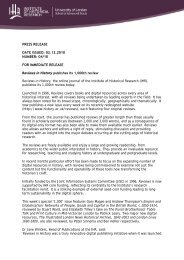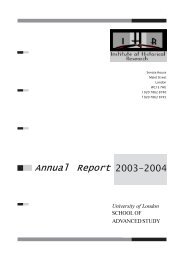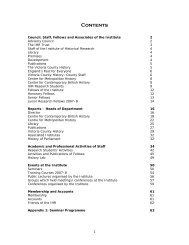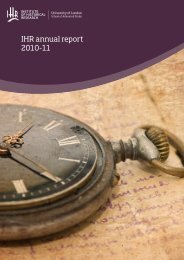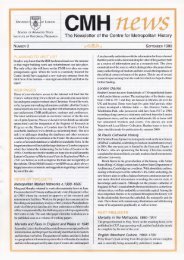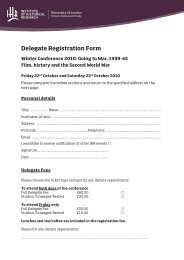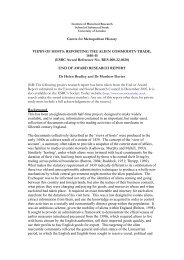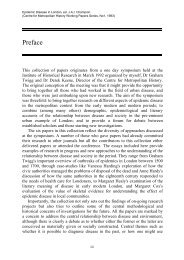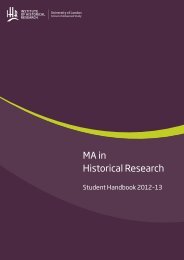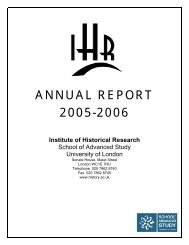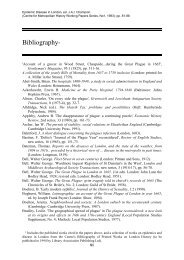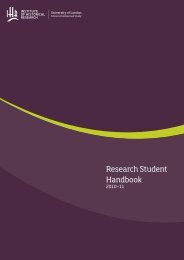CMH AnnuAl RepoRt 1999â2000 - Institute of Historical Research
CMH AnnuAl RepoRt 1999â2000 - Institute of Historical Research
CMH AnnuAl RepoRt 1999â2000 - Institute of Historical Research
You also want an ePaper? Increase the reach of your titles
YUMPU automatically turns print PDFs into web optimized ePapers that Google loves.
Markets and Fairs in Thirteenth-Century England<br />
the king. The grants have also been considered in their context ‘on the ground’,<br />
that is within the spatial and temporal network <strong>of</strong> existing markets and fairs. An<br />
additional factor to be considered is the impact <strong>of</strong> a movement against Sunday<br />
trading, promoted by the papacy, which was highly topical. Initial results indicate<br />
that many recipients <strong>of</strong> grants <strong>of</strong> markets and fairs were closely connected to<br />
the regent, suggesting that issues <strong>of</strong> patronage and the political context <strong>of</strong> grants<br />
will be a rewarding area for further research. The impact <strong>of</strong> the anti-Sunday<br />
trading movement also appears to have been significant. The effect <strong>of</strong> this on<br />
local market networks will be analysed over the next few months.<br />
The second theme <strong>of</strong> the project will be to consider markets and fairs from<br />
the point <strong>of</strong> view <strong>of</strong> the individuals who owned them. The most important<br />
individual will be the king: as a major landlord, he directly controlled many<br />
trading institutions on his estates. This study will be the first to investigate the<br />
administration <strong>of</strong> markets on the royal demesne on a national scale. Few <strong>of</strong> the<br />
county studies <strong>of</strong> markets so far published deal with royal markets and fairs.<br />
The investigation will assess the chronology and location <strong>of</strong> markets and fairs<br />
on the royal demesne, and will consider how they fitted into existing networks<br />
<strong>of</strong> trade. The reasons for the establishment <strong>of</strong> these markets and fairs will be<br />
examined, including the provisioning <strong>of</strong> the royal household, their potential as a<br />
means to raise income and as status symbols. It is likely that this will concentrate<br />
on the 1230s and 1240s. The other major landlord to be studied will be Peter<br />
des Roches, bishop <strong>of</strong> Winchester (1205–38).<br />
Another theme will be the legal, administrative and financial restrictions on<br />
marketing enforced by the king. Overall, these changes increased the need for<br />
access to the king, who thus acquired new opportunities for patronage. and thus<br />
made the issue <strong>of</strong> grants a potential object <strong>of</strong> royal patronage. Key questions in<br />
this part <strong>of</strong> the study concern the degree to which John and Henry III exploited<br />
those opportunities, and the way in which additions and adjustments to the<br />
network <strong>of</strong> trading institutions reflect contemporary perceptions and practice<br />
in its operation.<br />
The main focus <strong>of</strong> the project will be to produce a monograph. It is hoped that<br />
several papers will be given during the course <strong>of</strong> the project including one at<br />
the Thirteenth Century England conference at Durham in 2001. A page for the<br />
project has been set up on the <strong>CMH</strong> website and further news will be posted at<br />
.<br />
15



